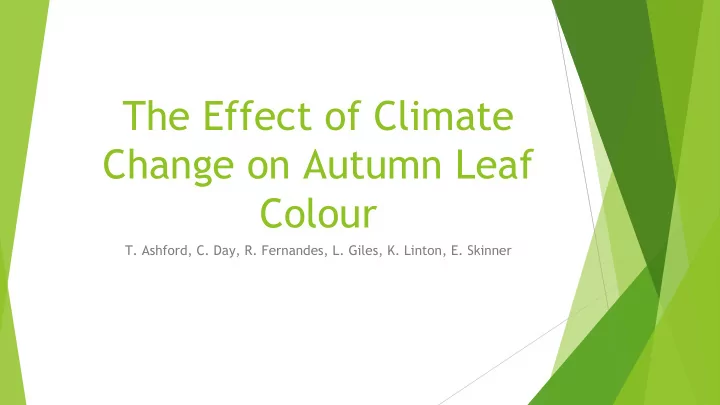

The Effect of Climate Change on Autumn Leaf Colour T. Ashford, C. Day, R. Fernandes, L. Giles, K. Linton, E. Skinner
Why Leaf Colour Change? An Image of New England (Telegraph, 2016)
The Pigments Chlorophyll ● Chemical Structure of Anthocyanin Green ● (Goto and Kondo, 1991) Present for most of the year ● Used for photosynthesis ● Concentration reduced in ● autumn Carotenoids ● Yellow ● Chemical Structure of Carotenoids (Adapted from Biswal,1995) Present for the whole year ● Masked by Chlorophyll ● Photoprotective ● Anthocyanin ● Red ● Produced during the autumn ● Chemical Structure of Chlorophyll period (Adapted from Konwar and Baruh, 2013) Photoprotective ●
What did we do? Method: Chose temperature and CO 2 ● concentration. Narrowed down our search from global ● to New England. Excluded precipitation, weather and ● daylight hours. Investigated the effect temperature and ● CO 2 had on our three pigments. Results: Completed a sign test for each pigment on the literature results. ● Used the sign test results to predict how future colour change will be ● effected and the impacts.
Temperature and Pigments The table below shows the effect increasing temperature has on the concentration of the 3 pigments we have looked at: Pigment Effect on Concentration Sign Test Result • Chlorophyll Low temperature- little change N/A • Intermediate temperature- increase • High temperature- no change Carotenoids Increase 96.4% certainty Anthocyanin Decrease 96.5% certainty Concentration A graph to show the relationship between Chl concentration and of Chl temperature. Temperature/ o C
How will temperature change in New England? The graph shows: Current average monthly ● temperature in New England Future predicted monthly ● temperatures in 2100 The temperature currently ● associated with the onset of Autumn is 16˚ C, this will be delayed by about 4 weeks by 2100. A graph to show how temperature changes annually in New England in the years 2015 and 2100 separately.
CO 2 and Pigments The table below shows the effect increasing CO 2 has on the concentration of the 3 pigments we have looked at: Pigment Effect on Concentration Sign Test Result Chlorophyll No concentration change, 96.5% certainty but delayed degradation. Some exceptions. Carotenoids Inconclusive 50% certainty Anthocyanin Increase 97.8% certainty
How will CO 2 change in New England? Can use worldwide CO 2 projections ● to look at New England. Potential pathways vary with ● projections ranging from 600ppm to 850ppm by the year 2100. Currently levels around 400ppm so ● a 50-112% increase can be expected. A figure to show how atmospheric CO 2 concentration throughout the world remains relatively constant (NASA, 2013)
Autumn Onset and its Rates Temperature ● The temperature associated with autumn onset will be delayed by approximately 4 weeks. Additionally, the rate at which the leaf changes colour is faster. CO 2 ● The autumn onset is further delayed and the rate at which the leaf changes colour from yellow to red is faster. Overall ● Autumn onset will be delayed by 4 weeks or more with a faster rate at which the leaf changes colour.
Why is this relevant? The impacts are; Globally: ● Carbon sequestration - delayed leaf colour change, longer growing season, increased carbon sequestration, decreased carbon dioxide concentration Albedo - delayed leaf colour change, decreased albedo, positive radiative forcing, increased temperature New England: ● “Autumn foliage tourism” - longer growing season, delayed leaf colour change, shorter tourism season, decreased tourism industry
Biological Impacts: Some animals respond to the UV/VIS light reflected from leaves which affects ● mating and migratory patterns many animals rely on leaves as their food source. The later onset of autumn ● means animals will have a food source for longer. Moose (All About Moose, 2016) Leaf Miner (Plant Natural, 2016) Yellow-Bellied Sap Sucker (Huffman, L., 2016)
References ● All About Moose. http://www.all-about-moose.com/moose-pictures.html, Accessed March 2016 ● Biswal, B. 1995. Carotenoid Catabolism during leaf senescence and its control by light. Journal of Photochemistry and Photobiology 30, 3-13. ● Goto, T., Tamura, H., Kawai, T., Hoshino, T., Harada, N. and Kondo, T. 1986. Chemistry of Metalloanthocyanins. Annals of the New York Academy of Sciences 471, 155-173. ● Huffman, L. http://www.audubon.org/guia-de-aves/ave/yellow-bellied-sapsucker, Accessed March 2016 ● Konwar, M. and Baruah, G.D. 2013. A Possible Realization of Chlorophyll Laser. Optics and Photonics Journal 3, 385-387. ● NASA. 2013. Earth Observatory. Available at: http://earthobservatory.nasa.gov/IOTD/view.php?id=82142 ● Planet Natural. http://www.planetnatural.com/pest-problem-solver/houseplant- pests/leafminer-control/, Accessed March 2016 ● Telegraph. 2016. New England in the Fall: Trip of a Lifetime. Available at: http://www.telegraph.co.uk/travel/activityandadventure/9590099/New-England-in- the-Fall-Trip-of-a-Lifetime.html
Thank you for Listening Any Questions?
Recommend
More recommend